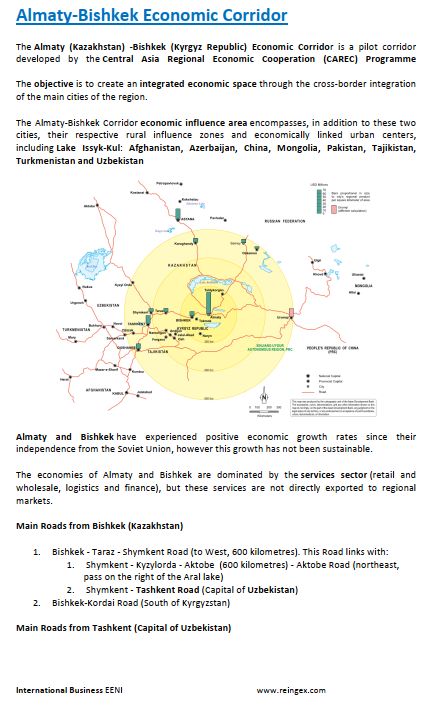Almaty-Bishkek Economic Corridor, Central Asia
Kazakhstan, Kyrgyzstan: Almaty-Bishkek Economic Corridor (CAREC)
The Almaty (Kazakhstan) -Bishkek (Kyrgyz Republic) Economic Corridor is a pilot corridor developed by the Central Asia Cooperation (CAREC).
The objective is to create an integrated economic space through cross-border integration of the main cities of the region.

- Introduction to the Almaty-Bishkek Economic Corridor
- Member countries: Kazakhstan and Kyrgyzstan
- Main features of the Almaty-Bishkek Economic Corridor
- The Almaty-Bishkek Economic Corridor: a key project of the Central Asia Regional Economic Cooperation (CAREC) Programme
- Economic impact on the CAREC Member countries of the Almaty-Bishkek Economic Corridor: Afghanistan, Azerbaijan, China, Mongolia, Pakistan, Tajikistan, Turkmenistan and Uzbekistan
- Kyrgyzstan-Iran Logistics Corridor
- Islamabad-Istanbul Logistics Corridor
Sample - Almaty-Bishkek Economic Corridor


The Subject “Almaty-Bishkek Economic Corridor” is included within the curriculum of the following academic programs at EENI Global Business School:
Logistics Courses: Road transport, Multimodal Transport, Rail transport.
Certificate in International Transport

Masters: International Transport, International Business.


Languages:  or
or  Corridor Almaty-Bishkek
Corridor Almaty-Bishkek  Corredor Almaty-Bishkek
Corredor Almaty-Bishkek  Corredor Almaty-Bisqueque.
Corredor Almaty-Bisqueque.

Countries of the area of influence of the Almaty-Bishkek Economic Corridor (CAREC Members):
The Almaty-Bishkek Corridor economic influence area encompasses, in addition to these two cities, their respective rural influence zones and economically linked urban centers, including Lake Issyk-Kul.
- Afghanistan
- Azerbaijan
- China
- Mongolia
- Pakistan
- Tajikistan
- Turkmenistan
- Uzbekistan

Distance Almaty-Bishkek: 240 kilometers
- Corridor development: 10 - 15 years
- Project (road): Kenen - Otar - Gvardeysky - Matibulak axis, located between Almaty-Bishkek, with an estimated population of 30,000 people
Almaty and Bishkek have experienced positive economic growth rates since their independence from the Soviet Union, however this growth has not been sustainable.
The economies of Almaty and Bishkek are dominated by the services sector (retail and wholesale, logistics and finance), but these services are not directly exported to regional markets.
Key economic sectors:
- Agriculture and agribusiness. Clusters:
- Fruits and vegetables
- Dairy and cattle
- Educational services
- Foreign Trade (export-oriented, knowledge-intensive services)
- Health
- Important mining areas
- Renewable energy production
Main Roads related to the Almaty-Bishkek Economic Corridor
Main Roads from Bishkek (Kazakhstan)
- Bishkek - Taraz - Shymkent Road (to West, 600 kilometers).
This Road links with:
- Shymkent - Kyzylorda - Aktobe (600 kilometers) - Aktobe Road (northeast, pass on the right of the Aral lake)
- Shymkent - Tashkent Road (Capital of Uzbekistan)
- Bishkek-Kordai Road (South of Kyrgyzstan)
Main Roads from Tashkent (Capital of Uzbekistan)
Tashkent is a major logistics hub in Central Asia.
Tashkent - Djizzak- Samarkand Road (to West). This Road links with:
- Samarkand - Navoi - Bukhara Road. This Road links with:
- Bukhara - Urgench - Nukus Road. Left of the Aral Sea
- Bukhara - Mary Road (Turkmenistan)
Samarkand - Harat (Afghanistan) Road. Links to Maraz-el Sharif, Kunduz, Kabul and Jalalabad
Tashkent - Dushanbe Road (Tajikistan)
- Links to Maraz-el Sharif, Kunduz, Kabul and Jalalabad (Afghanistan)
- Dushanbe- Sinkiang Uyghur Autonomous Region (China)
- Urumqui (900 kilometers) Road. Access to:
- Urumqui - Khovd (Mongolia) - Ulgli Road
There is another Road that connects Namangan, Andijan and Osh (Kyrgyzstan).
Main Roads from Almaty (Kazakhstan)
- Alamaty-Urumqui China Road (900 kilometers)
- Almaty - Taldykorga - Semey Oskemen Road (northeast, 900 kilometers, passes east of Lake Baikal)
- Almaty - Karaghandy - Astana (Capital) - Kostanai Road (to
northeast, 900 kilometers, passes west of Lake Baikal). Access to Kokshetau
- Access to Petropavlosk (Russia)
- Almaty-Uzynagash Road (North of Kazakhstan)
- Railway nodes in Kazakhstan in the north, center and south
Azerbaijan: there are no direct connections with the Almaty-Bishkek Economic Corridor
Asian regional economic communities related to the Almaty-Bishkek Economic Corridor
Both Kazakhstan and the Kyrgyz Republic are members of the Eurasian Economic Union and WTO.
- Eurasian Economic Union: Armenia, Belarus, Kazakhstan, Kyrgyzstan and Russia
- Shanghai Cooperation Organization: Kazakhstan, China, Kyrgyzstan, Russia, Tajikistan and Uzbekistan
- Economic Cooperation Organization (ECO): Afghanistan, Azerbaijan, Iran, Kazakhstan, Kyrgyzstan, Pakistan, Tajikistan, Turkey, Turkmenistan and Uzbekistan
- Commonwealth of Independent States: Armenia, Azerbaijan, Belarus, Kazakhstan, Kyrgyzstan, Moldova, Russia, Ukraine, Tajikistan, Turkmenistan and Uzbekistan
- Turkic Council: Azerbaijan, Kazakhstan, Kyrgyzstan and Turkey
- Organization for Cooperation between Railways (OSJD): Azerbaijan, Albania, Afghanistan, Belarus, Bulgaria, Hungary, Vietnam, Georgia, Iran, Kazakhstan, China, North Korea, South Korea, Cuba, Kyrgyzstan, Latvia, Lithuania, Moldova, Mongolia, Poland, Russia, Romania, Slovakia, Tajikistan, Turkmenistan, Uzbekistan, Ukraine, Czech Republic and Estonia
- Organization for Democracy and Economic Development (GUAM). Azerbaijan
- Black Sea Cooperation. Azerbaijan
- Asia-Africa Growth Logistics Corridor: Mongolia
- Asian Clearing Union: Pakistan
- APEC: China
- Greater Mekong Subregion: China
Transport and logistics related to the Almaty-Bishkek Economic Corridor
- The Five Corridors of the Central Asia Regional Economic Cooperation Program (CAREC)
- Bangladesh-Myanmar Logistics Corridor
- China-Russia Logistics Corridor
- Europe-Caucasus-Asia Logistics Corridor
- China-Pakistan Logistics Corridor
- Afghanistan-Turkey Logistics Corridor
- India-Afghanistan Logistics Corridor
- Trans-Siberian Railway (Russia, North Korea)
- North-South Corridor (India-Russia)
- Corridor of the Ashgabat Agreement
- China-Central-West Asia Logistics Corridor
- Trans-Caspian Logistics Corridor
- Nanning-Singapore Logistics Corridor

Related Trade Agreements
- Kazakhstan
- Customs Union with Russia and Belarus
- Trade Agreements with Armenia, Ukraine and Georgia
- Cooperation agreement with the European Union
- Kyrgyzstan
- Economic and Trade cooperation agreement with Pakistan
- Trade Agreements with Armenia, Moldova, Ukraine and Uzbekistan
- Tajikistan
- Trade Agreements with Armenia, Ukraine and with the Eurasian Economic Union
- Turkmenistan
- Trade Agreements with Armenia, Georgia and with the Eurasian Economic Union
- Uzbekistan
- Trade Agreements with Kyrgyzstan, Ukraine, Georgia and with the Eurasian Economic Union
- Azerbaijan
- Trade Agreements with Russia, Ukraine and Georgia
- Free trade agreement between Georgia, Ukraine, Azerbaijan and Moldova
- The European Union Eastern Partnership
- Pakistan
- Preferential Trade Area with Mauritius
- Trade Agreements with China, ASEAN, Sri Lanka, India, the European Union
- Iran-Pakistan Preferential trade agreement
- China
- Trade Agreements with the ASEAN, Singapore, New Zealand, Peru, Costa Rica, Chile, APEC, European Union...
- Asia-Pacific Trade Agreement: Bangladesh, China, India, Mongolia and Sri Lanka
- Islamic Trade Preferential System (TPS-OIC)
Main Asian institutions related to the Corridor
- Asian Development Bank
- Economic Commission for Asia (ESCAP)
- Boao Forum for Asia
- Colombo Plan
- Asia Cooperation Dialogue
Main Islamic institutions
- Organization of Islamic Cooperation (OIC)
- Islamic Development Bank
The main Religions of the region of the Almaty-Bishkek Economic Corridor are:
- Orthodoxy (Christianity)
- Islam
- Buddhism (China and Mongolia)
(c) EENI Global Business School (1995-2025)
Top of this page









 WhatsApp
WhatsApp
